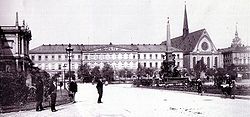
Augusteum (Leipzig)
Encyclopedia

Augustusplatz
The Augustusplatz is a square located at the east end of the city centre of Leipzig. It is the city's largest square and one of the largest squares in Germany...
in Leipzig
Leipzig
Leipzig Leipzig has always been a trade city, situated during the time of the Holy Roman Empire at the intersection of the Via Regia and Via Imperii, two important trade routes. At one time, Leipzig was one of the major European centres of learning and culture in fields such as music and publishing...
, to the left of the Paulinerkirche
Paulinerkirche, Leipzig
The Paulinerkirche was a church on the Augustusplatz in Leipzig, named after the "Pauliner", its original Dominican friars. It was built in 1231 as the Klosterkirche St. Pauli for the Dominican monastery in Leipzig. From the foundation of the University of Leipzig in 1409, it served as the...
. It was the original site of the University of Leipzig
University of Leipzig
The University of Leipzig , located in Leipzig in the Free State of Saxony, Germany, is one of the oldest universities in the world and the second-oldest university in Germany...
.
History
It was built between 1831 and 1836 to plans by Albert GeutebrückAlbert Geutebrück
Albert Geutebrück was a German classicist architect, especially active in Leipzig, where his works included the Augusteum....
, though its facade referred back to a classicist
Neoclassical architecture
Neoclassical architecture was an architectural style produced by the neoclassical movement that began in the mid-18th century, manifested both in its details as a reaction against the Rococo style of naturalistic ornament, and in its architectural formulas as an outgrowth of some classicizing...
design by Karl Friedrich Schinkel
Karl Friedrich Schinkel
Karl Friedrich Schinkel was a Prussian architect, city planner, and painter who also designed furniture and stage sets. Schinkel was one of the most prominent architects of Germany and designed both neoclassical and neogothic buildings.-Biography:Schinkel was born in Neuruppin, Margraviate of...
. The building had, however, already reached its full capacity by the 1870s since the university had grown due to major urban expansion in this period. The building was generously rebuilt and expanded from 1892 to 1897 by the architect Arwed Rossbach. The Augusteum had originally only had a front onto the Augustusplatz, but (due to the demolition of the Paulinum
Paulinum (University of Leipzig)
The Paulinum was a building located on the eastern outskirts of the secularised Dominican monastery in Leipzig and used by the University of Leipzig from 1543 as the Collegium Paulinum....
) could now receive a south wing known as the Johanneum (1895), a middle wing known as the Albertinum (1896) and a west wing known as the Paulinum (1896). The renovation also altered the building's style to fit in better with other buildings on the Augustusplatz, with Neo-Renaissance and Neo Gothic facades being added to the Paulinerkirche and Augusteum to plans by Rossbach.
Heavily damaged by bombing in the Second World War, the Augusteum was decided by the East German government to be beyond repair and (like the fully intact Paulinerkirche) ill-fitting for their concept of a socialist-orientated university. Thus the two buildings were dynamited on 30 May 1968. This cleared an area on which a new university complex in functional and sober DDR architectural style was built in 1975. Until 1971 a rectory building was on the site of the Augusteum's main wing.
After reunification a "citizens' initiative for the reconstruction of the university church and Augusteum of Leipzig" gathered but after years of litigation demands for reconstruction have been waived in favour of the university's need for modern teaching and research facilities. A plan has been drawn up by Erick van Egeraat of a campus building recalling parts of the Augusteum's facade and an auditorium designed to appear like the Paulinerkirche, but the historic main building of university will not rise again.
Reconstruction
Since 2006, the campusCampus
A campus is traditionally the land on which a college or university and related institutional buildings are situated. Usually a campus includes libraries, lecture halls, residence halls and park-like settings...
Augustusplatz, consisting of the main building (Hauptgebäude) at the place of former Augusteum and Paulinerkirche, the lecture hall building (Hörsaalgebäude), seminar building (Seminargebäude) and dining hall building (Mensagebäude), has been under reconstruction. The new building for the Faculty of economic sciences and parts of the renovated seminar building have been finished, the long overdue new dining hall building has nearly been finished, and the other parts, including the new Augusteum and Paulinum are still under heavy construction.

